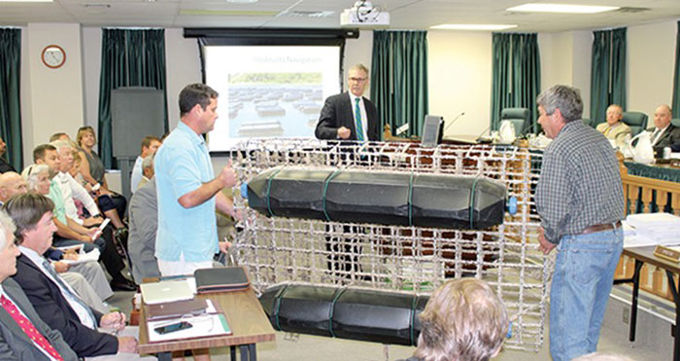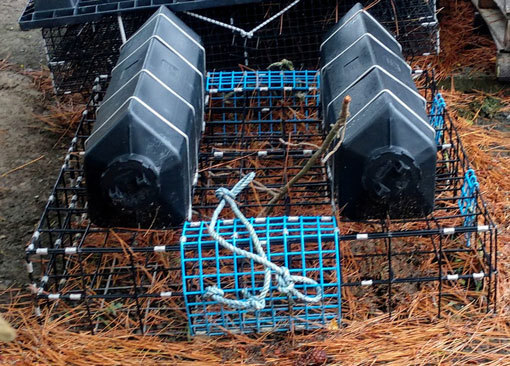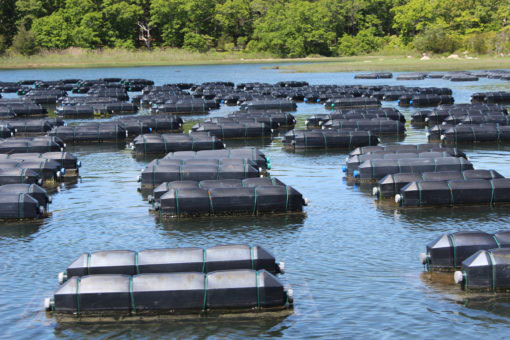
Riparian & Waterfront Property Rights at September 2018 VMRC Meeting
"VMRC decisions have direct and immediate consequences affecting the riparian property rights of Virginia's water front property owners. The VMRC makes these decisions at monthly meetings which are open to public. We attend the monthly VMRC meeting to represent our clients or as observers, and provide our readers a summary of the important cases."
The Virginia Marine Resources Commission (VMRC) is the state agency that manages Virginia’s marine resources. The VMRC regulates the fisheries and shellfish industries and issues permits for encroachments over state-owned submerged lands. It also manages the Virginia Wetlands Act, and the Coastal Primary Sand Dune Protection Act. VMRC decisions have direct and immediate consequences affecting the riparian property rights of Virginia's water front property owners. The VMRC makes these decisions at monthly meetings which are open to public. We attend the monthly VMRC meeting to represent our clients or as observers, and provide our readers a summary of the important cases.
The September meeting took place on September 25th, 2018 at 9:30.
The first contested matter was the application of Kevin Wade, JPA #18-0496, to install 714 floating oyster cages in a 5.5 acre area in Milford Haven, adjacent to Gwynn’s Island in Grimstead, Virginia. We represented a waterfront property owner opposed to the project.
Virginia aquaculture has for decades been accomplished with cages or with spat on shell placed on the bottom of the water body. Floating equipment recently came into vogue because it produces a higher quality oyster and it does so more quickly than traditional on-the-bottom oyster aquaculture. Oystermen chasing higher profit are generating intense user conflict when they seek authorization to place floating aquaculture cages near water front property, especially residential water front property. This photo shows one of the 714 cages, each measuring 4’ by 3’ and equipped with two black plastic floats, that Mr. Wade proposes to install in Milford Haven:

This next photo shows the appearance of about 60 cages of similar design deployed in the water in another project, at another location:

Mr. Wade proposes to install approximately 12 times the number of cages depicted in the previous photo. The intense widespread public backlash to these floating aquaculture projects comes from waterfront property owners who want to protect their riparian property rights, including their right to navigate in the water body. If they allow the government to compromise their riparian property rights, their water front property loses value. (In August 2018 Governor Northam reacted to the backlash by establishing the “Governor’s Work Group to Promote Sustainable Growth of Virginia’s Clam and Oyster Economy”, which is the topic of a companion article on this blog.)
"The intense widespread public backlash to these floating aquaculture projects comes from waterfront property owners who want to protect their riparian property rights, including their right to navigate in the water body. If they allow the government to compromise their riparian property rights, their water front property loses value. (In August 2018 Governor Northam reacted to the backlash by establishing the “Governor’s Work Group to Promote Sustainable Growth of Virginia’s Clam and Oyster Economy”, which is the topic of a companion article on this blog)"
This was the second contested application for floating aquaculture to come before the Commission in 2018, the prior one being an application submitted by Rappahannock Oyster Company for an 11 acre site in the Rappahannock River near Locklies Creek that was heard at the May 2018 meeting. As noted in a companion post on this blog, we represented the lead protester opposing Rappahannock Oyster Company at the May 2018 meeting. The VMRC denied that application after a lengthy and heavily contested hearing. We likewise represented the lead protester opposing the Wade application. The hearing on the Wade application at the September meeting was lengthy and heavily contested but, unlike the result at the May hearing, the Commission approved the Wade application at the September hearing on a 4-2 vote (Associate Commissioners Lusk and Minor abstained). Following the adverse decision of the VMRC on the Wade application, we shifted the fight to the U.S. Army Corps of Engineers (US ACE). Mr. Wade cannot build the project if the US ACE denies the permit the project requires pursuant to section 404 of the Clean Water Act and section 10 of the Rivers and Harbors Act. Also, following the adverse decision of the VMRC, another law firm has filed an appeal that will trigger court review (and potential reversal) of the VMRC decision on the Wade application.
Two contested infrastructure projects also came before the Commission at the September meeting. Our proprietary data shows that year to date in 2018 the Commission has approved every contested infrastructure permit that has come before it for hearing and decision, even in those cases where the VMRC staff recommended disapproval. The result at the September 2018 Commission meeting was no different.
- DEPARTMENT OF THE ARMY, #18-1146: This was an infrastructure matter, in which the Department of the Army was requesting a permit to construct 215 linear feet of riprap revetment within non-vegetated wetlands and to install three open-pile piers along the Appomattox River at the Mechling Training Center in Fort Lee. The project required both a subaqueous and a wetlands permit. The VMRC Staff recommended approval, and the Commission voted unanimously to approve the permits.
- PRESERVE ON ELIZABETH OWNERS ASSOC., #18-1189: In this infrastructure matter, the Association requested authorization to construct a 6-foot wide by 107-foot long community pier, which included a kayak ramp and access stairs, along the Intercoastal Waterway. The project also included construction of 483 feet of marsh toe and the planting of native wetland vegetation, to offset the wetlands that would be impacted by the construction. The project required a wetlands permit. The VMRC Staff recommended approval, and the Commission voted unanimously to approve the permit.
The Commission next took up a permit concerning a contested oyster lease in the Rappahannock River. Our proprietary data shows that year to date in 2018 the Commission has approved 73% of the contested oyster lease applications that have come before it for hearing and decision.
- ANDREW A. KURFEES, Oyster Planting Ground Application #2018-060; in this oyster lease matter, Mr. Kurfees requested authorization to lease up to 204 acres within the Rappahannock River. The application was protested a nearby property owner and an adjacent leaseholder. The protestors filed written objections to the lease, citing concerns that it would negatively impact navigation. However, unlike the Wade matter described above, in this case none of the protesters were present to voice their opposition, and they were not represented by counsel. The VMRC Staff recommended approval, and the Commission voted unanimously in favor of the lease. The entire matter was before the Commission for just over seven minutes.
The VMRC also meted out punishment for a wetlands violation at the September meeting. The case was brought on application of Brian Rechtenbaugh (JPA #17-1334. Mr. Rechtenbaugh needed an “after the fact” permit and illustrates why water front property owners would benefit from consulting an experienced waterfront property rights attorney prior to construction activity near a wetland. This was an “after the fact” request by a property owner who filled in a portion of the tidal wetlands on his property. Mr. Rechtenbach owns property along a tributary of the Elizabeth River. In 2016, he filled in part of his property in response to tidal flooding that began after Hurricane Mathew. He stated that flooding was consistently approaching the crawlspace of his house, particularly in the months of September and October.
The VMRC has two options in a case like this – to allow the applicant to retain the fill while requiring the him to mitigate the damage by restoring an equivalent amount of wetland area, or to require that the fill be removed and the wetlands restored to the original condition. Mr. Rechtenbach desired to retain his filled in area, and build new wetlands to offset the ones he filled in.
In “after the fact permits,” one important factor that the VMRC will consider is whether the permit, had it been applied for prior to the construction, would have been approved. In this case the VMRC Staff testified that the permit most likely would have been approved, but with modifications. The VMRC Staff recommended that Mr. Rechtenbach be allowed to retain his fill while also restoring 1250 feet of tidal wetlands to offset the fill, in addition to paying a $6000 civil penalty for ”moderate” non-compliance with the Virginia Wetlands Act. Mr. Rechtenbach was present at the hearing, but was not represented by counsel. He testified that he had hired a contractor to perform the work, and that he believed the contractor had taken care of all the required permits. He requested that the fine be reduced to $2000 dollars.
Chairman Bowman replied that he believed that Mr. Rechtenbach had made improvements to his property for his own purposes, with no regard to the environment whatsoever, and that this was an “egregious violation.” After some discussion, Mr. Rechtenbach agreed to pay the recommended $6000 fine. Associate Commissioner Everett then made a motion to require Mr. Rechtenbach to restore the land to its original size, shape and condition, despite the fact that this condition caused water to come very close to Mr. Rechtenbach’s home and would likely have resulted in his having to file a new permit to keep the flooding at bay. The Commission discussed this at length, ultimately deciding to continue the case until next month’s meeting to allow the Staff more time to work with Mr. Rechtenbach to develop a workable mitigation plan. The Commission also discussed the potential liability of the contractor who performed the construction, and commented that the contractor issue would be discussed further when this matter comes before the VMRC again.
Of note, Mr. Rechtenbach’s project had also involved the destruction of existing trees, but this matter was not before the VMRC because it is being handled separately by the Chesapeake Bay Board.
Audio of the meeting is available at http://mrc.virginia.gov/calendar.shtm.
